- Home
- Curriculum
- Curriculum Intent
- facebook Share this page on Facebook
- twitter Tweet this page
- pinterest Pin this page
Curriculum Intent
Our curriculum is an explicit and deliberate guarantor of equality. Our curriculum is coherently planned and sequenced towards cumulatively sufficient knowledge and skills for the next stage of education. Our ambitious curriculum is designed to give all learners the passion for individual and communal pursuit of wisdom. We ensure that our curriculum gets children reading and keeps them reading using the Read, Write Inc programmes. Children are taught the right maths to ensure they're building on prior knowledge. Oracy runs through our curriculum like a golden thread to ensure we explicitly teach vocabulary and focus on speaking and listening. All children will have access to our broad and balanced curriculum.
Aims
- Engage children through interesting topics and hands-on activities.
- Make meaningful links between subjects.
- Develop children’s skills, knowledge and understanding of a range of themes and concepts.
- Make effective connections to the real world.
- Help children to think creatively and solve problems.
- Develop children’s capacities to work independently and collaboratively.
- Enable children to make choices about their learning.
- Take account of children’s interests and fascinations.
Our approach
- develops children to the best of their abilities
- helps children to find their passions and interests
- facilitates children’s acquisition of knowledge, skills and understanding
- helps children to develop intellectually, emotionally, socially, physically and morally
- assists children in becoming independent, responsible, useful, confident and considerate members of the community
- promotes a positive attitude towards learning, so children enjoy coming to school
- helps children to acquire a solid basis for lifelong learning
- creates and maintains an exciting and stimulating learning environment
- ensures that each child’s education has continuity and progression
- enables children to contribute positively within a culturally diverse society
Conerstones: Curriculum 22
Curriculum 22 is a capsule curriculum that is recommended for quick implementation. To fully understand how the curriculum works, please read the information set out below.
The Curriculum
Curriculum 22 is a broad and balanced, knowledge-rich primary curriculum. Its content is delivered through a range of subject-specific projects, which last either a full or half term.
Subject-specific projects cover art and design, design and technology, geography, history and, from spring 2022, science.
Maths is delivered through projects from the White Rose Maths scheme, and English is supported by a range of English packs.
Currently, we advise schools to use specialist schemes for computing, PE, PHSE, music and RE.
Understanding the structure
Curriculum 22 has four structural tiers. Each tier builds on the previous to create interconnected layers. These interconnected layers provide a robust framework that ensures connectivity across the curriculum. The tiers of the curriculum structure are set out in the diagram below, and explained in the following paragraphs.
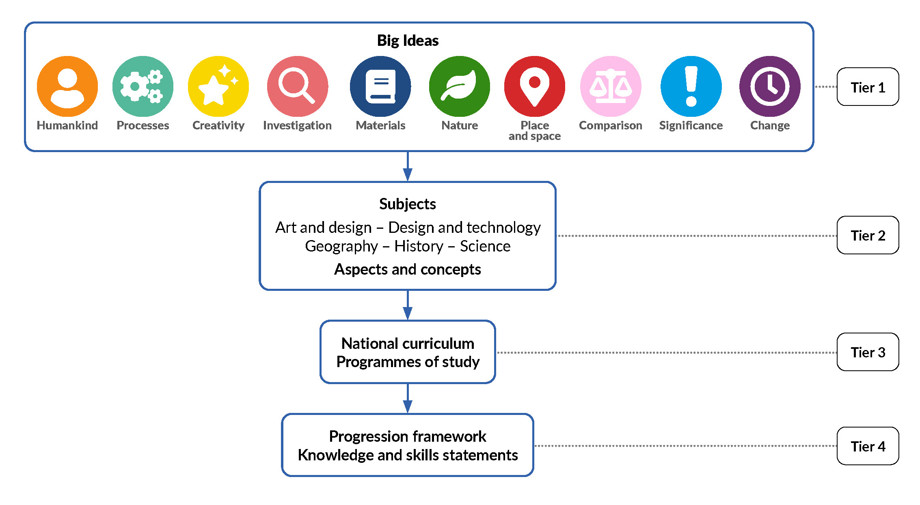
Tier 1 Big Ideas (global aims)
The curriculum is led by 10 central Big Ideas. These Big Ideas are the overarching aims of the curriculum. They were conceived by careful analysis of the national curriculum subjects, drawing out common themes, which then, through a period of refinement, became our Big Ideas. These Big Ideas and their intentions are set out below.
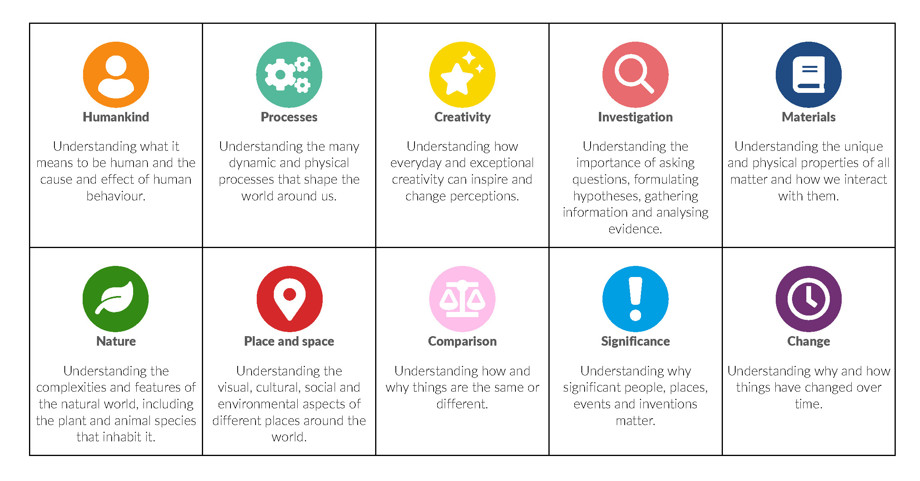
Tier 2: Subjects (aspects and concepts)
In Curriculum 22, we use the terms ‘aspects’ and ‘concepts’. An aspect is a particular part or feature of a subject, and a concept is an abstract idea within a subject.
In the curriculum structure, each Big Idea is directly connected to the curriculum subjects, which have the relevant aspects or concepts through which the Big Idea can be delivered. For example, in geography, the Big Idea of Humankind is connected to and delivered through the geographical aspects of Settlements and land use and Human features and landmarks. In history, the Big Idea of Humankind is connected to and delivered through the historical aspects and concepts of Everyday life, Hierarchy and power, and Civilisations.
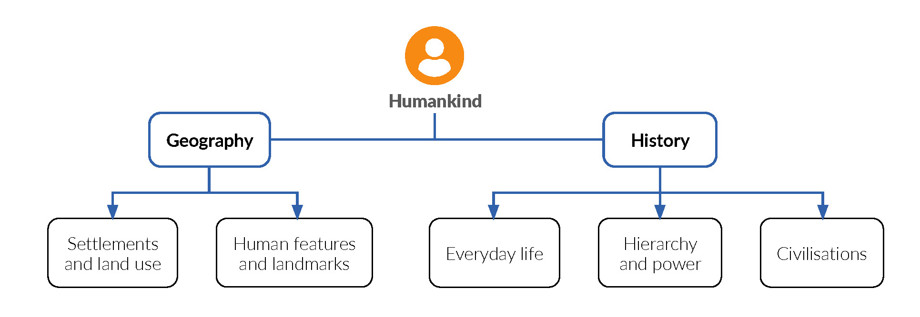
The diagram below shows how the Big Idea of Humankind is linked to each subject via its aspects and concepts.
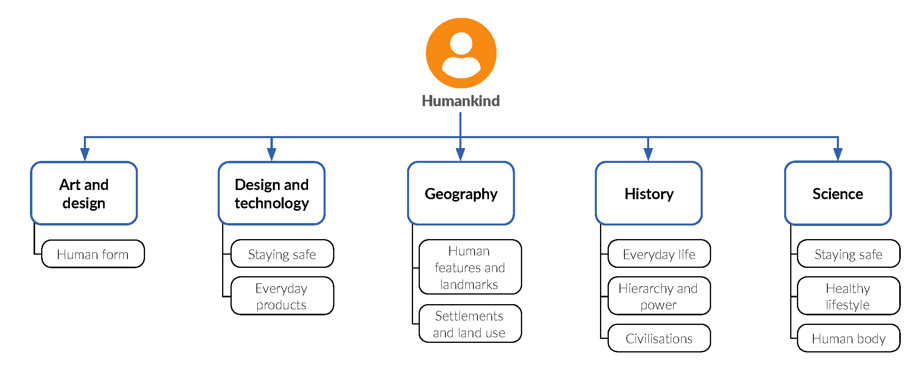
Tier 3: Programmes of study (national curriculum coverage)
To ensure coverage of the national curriculum, each subject aspect or concept is then matched to the relevant programmes of study. Across the curriculum, there is full coverage of the programmes of study for art and design, design and technology, geography, history and science. The diagram below shows an example of how Tier 2 leads into Tier 3.
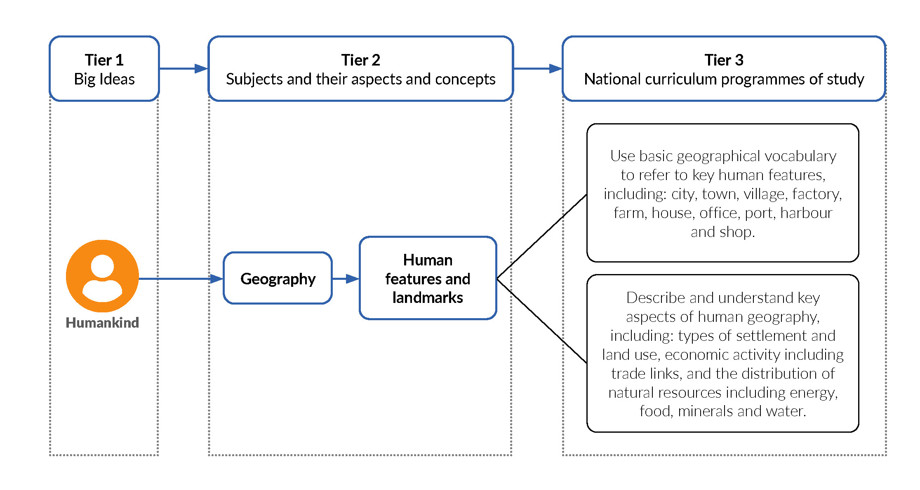
Tier 4: Progression framework (knowledge and skills statements)
In Tier 4, programmes of study, aspects and concepts are broken down into smaller component parts or ‘chunks’ to form a cohesive progression framework. The progression framework runs from Nursery to Year 6 and includes knowledge and skills that children need to know and be able to do in order to make progress through the curriculum.
|
COMPONENT PART |
DEFINITION |
|---|---|
|
Knowledge |
Specific facts or truth components that include substantive and declarative statements |
| Skills |
Application and use of composite knowledge. Skill statements will often contain implicit, procedural and disciplinary knowledge. |
The diagram below shows how a programme of study is broken down further into knowledge and skills statements for the aspect of Human features and landmarks in geography.
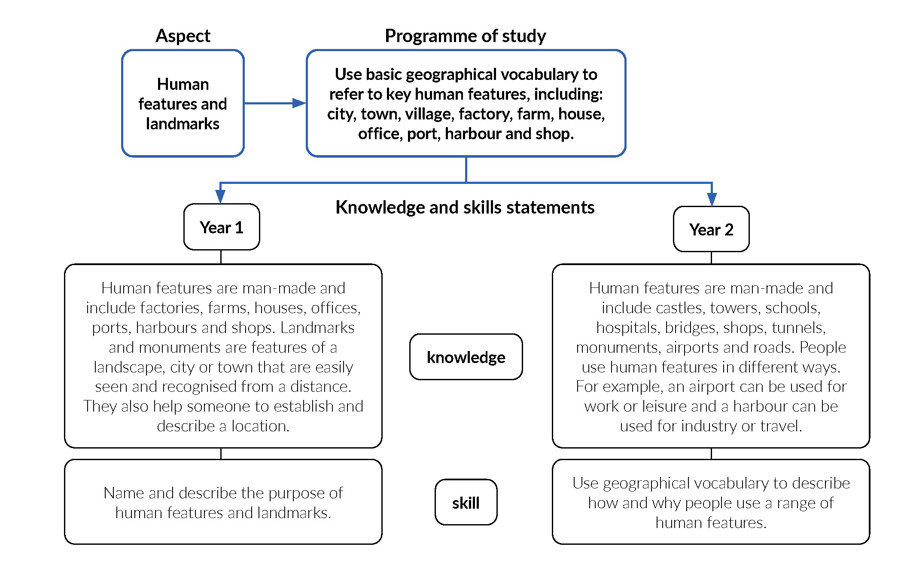
Teachers may decide, at a lesson level, to adapt or refine the individual statements even further. A teacher may decide to do this to create a series of smaller stepping stones to support learning for individual children or groups of children. However, schools are not advised to do this for all statements. The progression framework is more than sufficient to set out the learning pathways for an ambitious, broad and balanced curriculum.
Organisation of curriculum content in Curriculum 22
The structure of Curriculum 22 provides a robust framework on which to build deliverable content. The content is delivered through a range of broad and balanced, knowledge-rich projects. The knowledge and skills statements provide the foundation for, and are directly linked to, the sequential lesson plans and resources within each project. Each project follows the Cornerstones pedagogy of Engage, Develop, Innovate and Express.
The long-term plans, set out the projects for each year group and term. Projects are organised to maximise meaningful links between subjects, aspects and concepts.
Sequencing of subject content
In Curriculum 22, the national curriculum content is organised into projects. Where the curriculum has been split into year groups, we have organised our content in the same way. For other subjects, we have made decisions about the placement of content based on subject schema and the interconnectivity between subjects.
See our subject overviews for an explanation of how individual subject content for art and design, design and technology, geography, history and science are sequenced across Curriculum 22.
Knowing your curriculum
In order to make the most of Curriculum 22, you should make sure you are able to articulate its underpinning structure, placement and sequencing of content and any adaptations you have made. CurriculumPRO will help you do this.
Curriculum
- Behaviour - Ready, Respectful, Safe
- Classes
- Curriculum Intent
- Home Learning - Learning with Parents
- Inclusion
- Junior Citizenship
- Mathematics
- Music Lessons
- Our Curriculum
- Our Library
- Reading and Phonics
- School Council
- Sport and Health
- Subjects: Modern Foreign Language
- Forest School
- Memorable Experiences
- Year 6 Residential
- Enrichment Clubs
- Outdoor Learning and Play
- British Values
- Personal Development
- Eco School

